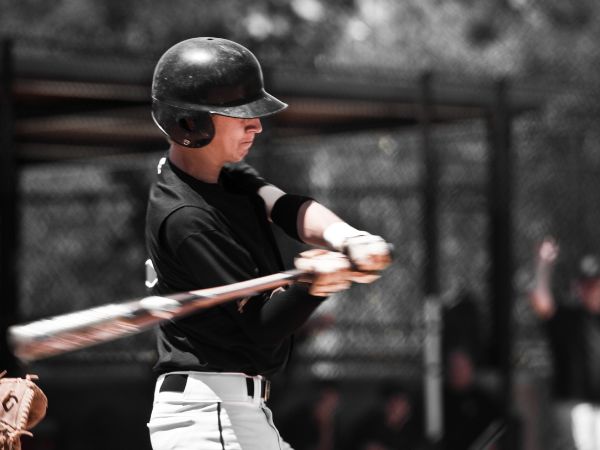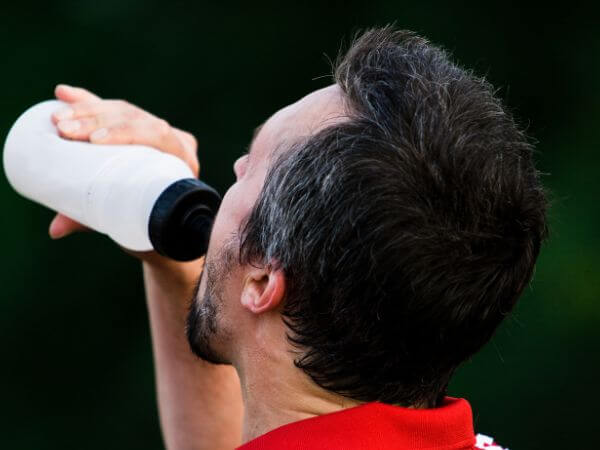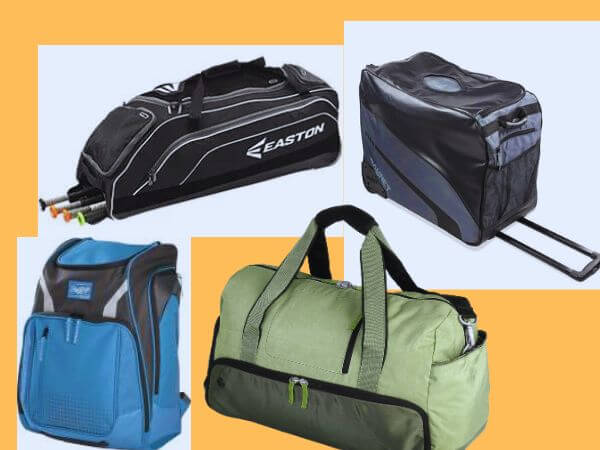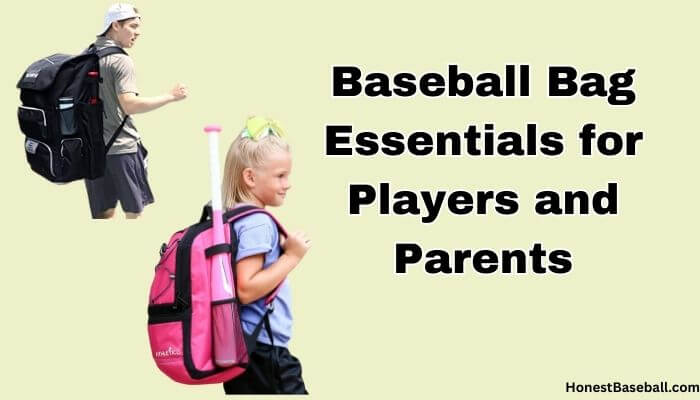Are you ready to step up your baseball game? Whether you’re a seasoned pro or just starting out, having the right gear is essential for success on the field.
And there’s nothing worse than forgetting an important item at home and feeling unprepared when it matters most.
That’s why I have put together a list of must-have baseball bag essentials that every player should have in their arsenal.
What to Pack in a Baseball Bag
Packing for a baseball game can be overwhelming, especially if you’re not sure what to bring. A well-stocked baseball bag ensures that you have everything you need to play your best and stay safe on the field.
Here are tips from my experience of playing baseball and working as a coach.
Baseball Gloves

Baseball gloves are one of the most essential pieces of equipment for any baseball player. They come in different sizes, materials, and designs to fit the needs of each position on the field.
For infielders, a smaller glove with shallow pockets is preferred to allow for quick transfers and throws. On the other hand, outfielders typically use larger gloves with deeper pockets to help catch fly balls more easily.
It’s important to break in your new baseball glove before using it in games or practices. This involves applying oil or cream to soften up the leather so that it molds better to your hand.
Taking good care of your baseball glove is crucial if you want it to last longer. Keep it clean by wiping away dirt after each game or practice session with a damp cloth, apply conditioner regularly, and store it properly when not in use.
Baseball Bats

Aluminum bats are more popular among younger players because they are lighter and easier to swing than wooden ones. They also have larger sweet spots, which make it easier for players to hit balls harder and farther. However, you should check out the list of the league you are playing for allowed bat types.
Related: 15 Best USSSA Bats 2023, 8 Best Youth Baseball Bats
When packing your baseball bag, handling your bats needs special care. First, make sure to secure your bats properly. Place them in a bat sleeve or wrap them in protective material to prevent scratches or damage.
Make sure they don’t move around too much inside the bag. Keep in mind that bats are the foundation of your sport, and handle them with care.
It’s up to you and your needs to decide how many bats you want to bring along. One or two bats are the norm for most players. It’s advisable to bring along a spare bat in case your main one gets broken or you just feel like switching things up.
In addition, some players find it advantageous to have bats of varying lengths and hefts at their disposal. It’s better to be safe than sorry, so think about how you like to play and bring the appropriate quantity of bats.
Always be prepared to hit a home run requires having the correct equipment on hand.
If you carry many bats you can check out this list of Best Softball Bat Bags where I listed the top bags for Baseball and Fastpitch softball.
Baseball Cleats
The right footwear is crucial for any baseball or softball player. That’s why investing in a good pair of baseball cleats can make all the difference on the field.
These essential footwear companions deserve proper care and consideration.
Ensure your cleats are clean and dry before packing them. Brush off any dirt or debris, and let them air out to prevent unpleasant odors.
Next, find a designated spot in your bag for the cleats. Keep them separate from other gear to avoid damage or dirt transfer.
Consider using a shoe bag or a dedicated compartment in your baseball bag to protect your cleats. This helps maintain their shape and prevents them from scratching other items. If space permits, position your cleats on top or in an easily accessible pocket for quick retrieval.
Batting Helmets
One of the most important pieces of protective gear for any baseball player is a batting helmet. While helmets may seem like a no-brainer when it comes to safety, not all helmets are created equal.
Your batting helmet is a crucial piece of protective gear, shielding your head from potential injuries. Before packing it, give it a quick inspection. Look for any cracks or damage that may compromise its effectiveness. Safety is the priority, after all.
Find a secure spot in your bag for the batting helmet. You want it to be well-protected and easily accessible when you need it. Consider using a helmet bag or a separate compartment to keep it separate from other equipment.
Remember, after each use, wipe down the helmet to keep it clean and fresh. Sweat and dirt can accumulate, so a quick wipe with a damp cloth does the trick.
Protective Gear

Don’t forget to include the essential protective gear. It’s crucial for keeping you safe during the game. Let’s take a closer look at what you need and how to pack it.
First, consider your position on the field and the specific protective gear required. If you’re a catcher, make sure to pack a durable chest protector, shin guards, and a catcher’s helmet. These items are designed to shield you from stray pitches and potential collisions at the plate. You can consider buying a Catcher’s Bag.
For other players, such as infielders and outfielders, it’s essential to wear a protective cup. This small but significant piece of gear provides added protection against unexpected impacts.
Designate a separate space for your protective gear. Keeping it apart from other equipment helps prevent damage and maintains its integrity.
Remember to regularly inspect and clean your protective gear for any signs of wear or damage. Check for frayed straps, loose padding, or any other issues that may compromise its effectiveness. If you notice any problems, promptly replace or repair the affected items
Baseballs and Equipment Bags
In baseball, the baseball itself is the most important tool. To make sure your squad has everything they need for a successful practice or game, stock up on lots of high-quality balls to use for both.
It’s smart to bring along extra baseballs just in case. It’s important to have extra balls on hand in case one is lost or broken during play, which can happen frequently during both training and games.
First Aid Kit
Injuries are typical in the sport of baseball. Having a first aid kit readily available is crucial. Bandages, gauze, and antibacterial wipes are all must-haves for every first-aid bag.
It’s also crucial to have baseball-specific first aid supplies, such as ice packs for muscular strains and sprains. Also, consider putting heel pads and sunscreen in your first-aid kit because they are often needed during long games.
The first aid equipment should always be within easy reach throughout games and sessions. If you want to be able to rapidly access your medical equipment, you might wish to carry it in a dedicated bag.
Make sure everyone on the team knows where the first aid box is kept and how to use its contents in an emergency. One of the best ways for teammates to show they care about each other’s safety while playing this popular sport is by keeping a well-stocked and easily accessible first aid kit on hand at all times throughout practice and games.
Water Bottles and Hydration

Baseball players, like any other athletes, need to make sure they drink plenty of water. If you’re not careful, dehydration can set very rapidly under the hot summer heat and from the activity of playing.
That’s why you should never forget to throw a water bottle into your baseball bag.
Choose a water bottle that will last and is simple to operate. If you don’t want your bag to become wet while being transported, make sure the lid is leak-proof. Also, think about insulating your water supply to keep it cool all day long.
Keep enough water available so that you can drink and keep hydrated all during the game or practice. Depending on the weather and how long you play, try for at least two full bottles per person.
Staying hydrated is important, but it shouldn’t be limited to water breaks; rather, it should be a constant effort during the game or practice. You should drink often, not just when you’re thirsty because thirst is a sign of dehydration.
Keep your energy up and avoid the aches and pains of muscle tiredness by drinking plenty of water throughout the day. Your baseball bag wouldn’t be complete without a high-quality reusable water bottle.
Snacks and Energy Bars
Snacks such as fruit, trail mix, and granola bars can give you the carbohydrates you need for quick bursts of energy. They also contain fiber that helps regulate digestion and keeps you feeling full throughout the game.
Energy bars come in handy when you need something more substantial than just a snack. They’re packed with protein which is essential for muscle recovery after strenuous exercise. Look for bars that have natural ingredients like nuts, seeds, or dried fruits instead of ones loaded with sugar and artificial additives.
It’s important to choose snacks and energy bars that are easy to eat on the go without getting messy or melting in the heat. Consider packaging them individually so they don’t get crushed in your bag.
Remember not to rely solely on these items as they shouldn’t replace proper meals before or after games/practices. Nonetheless, having a few snacks available can make all the difference when it comes to staying energized throughout a baseball game!
Miscellaneous Essentials
Apart from the essential equipment required for playing baseball, there are a few miscellaneous items that players should pack in their bags. These items may not directly impact performance but can be useful nonetheless.
The first thing is sunscreen or sunblock. Baseball games can last several hours, and players spend a lot of time under direct sunlight. To avoid getting sunburnt or risking skin damage, it’s crucial to use proper protection against harmful UV rays.
Another important item to consider is bug spray. Playing on grassy fields means dealing with mosquitoes and other pesky insects that can bite and cause irritation. Applying some bug spray before heading onto the field can help keep these bugs at bay.
It’s also recommended to carry a towel in your bag as well. This comes in handy when sweat starts pouring down your face during hot summer days or wiping off dirt and debris from your equipment between innings.
Don’t forget to pack extra socks! During long games or practices, feet tend to get sweaty and uncomfortable inside cleats leading to blisters and discomfort. Packing an extra pair of socks ensures you have dry feet throughout the game!
Packing miscellaneous essentials like sunscreen, bug spray, towels, and extra socks might seem trivial but they go a long way toward ensuring comfort during gameplay!
Types of Bags Available for Baseball Players

Now you know what you should include in your bag but what about the perfect bag?
There are a few different types of bags available for baseball players, each with its own unique features and benefits.
The first type of bag is the traditional duffel bag. These bags are large enough to hold all of your essentials and often have multiple compartments for organization. They also typically have handles and a shoulder strap for easy carrying.
Another popular option is the backpack-style bag. These bags allow you to carry all your gear on your back, leaving your hands free. They often come with specialized pockets for bats and helmets as well.
For those who want something more compact, there are equipment bags designed specifically for holding just one or two bats and some balls. These can be easily slung over the shoulder or carried by hand.
Rolling bags offer convenience when it comes to transporting heavier loads such as catcher’s gear or multiple bats. With wheels at the bottom of the bag, these make getting around much easier than carrying everything on your shoulders.
No matter which type of bag you choose, make sure it meets your needs in terms of size, functionality, and comfort while carrying.
Here are some articles to find you the perfect bag
Top Baseball Bags With Wheels In 2023
How to Organize Your Baseball Bag
Organizing your baseball bag can help you be more efficient and prepared for every game or practice.
The first step is to make sure you have a bag that fits all of your gear comfortably. Look for bags with multiple compartments so you can separate equipment by type.
Next, group similar items together to make them easier to find when you need them. For example, keep all of your batting gloves in one pocket and all of your protective gear in another.
Labeling different pockets or compartments can also be helpful. Use tags or stickers to mark where each item should go, so it’s easy to remember where everything belongs.
It’s important to regularly clean out your baseball bag as well. Remove any old snacks or empty water bottles and check for damaged equipment that may need replacing.
When packing up after a game or practice, take the time to put everything back in its designated spot. This will save time and frustration next time you need something from your baseball bag!
What Parents of Young Baseball Players Need to Know
Young baseball players rely heavily on their parents for support and guidance as they prepare for games and training.
Parents should make sure their kids always have a change of clothes and equipment in their baseball bags. It’s a good idea to have an extra uniform and some towels available in case the kids become dirty or sweaty during the game.
Another important consideration for parents is hydration. Children must stay hydrated before, during, and after games to avoid fatigue or heat exhaustion. Parents should pack plenty of water bottles or sports drinks as well as snacks like fruit or energy bars to keep their children fueled throughout the game.
Safety gear is also a must for young players. Protective helmets with face guards are essential for batting and catching positions while shin guards protect the legs when playing infield or outfield positions.
Additionally, sunscreen with high SPF protection will help prevent sunburns during daytime games.
Communication with coaches is key for parents of young baseball players. Coaches may have specific requirements regarding equipment or even practice schedules that could affect what items are needed in the player’s bag.
Parents can make sure their child is prepared for performance on the field and is secure and comfortable at all times by keeping these things in mind and packing accordingly.
Tips for Packing the Perfect Bag
Packing the perfect baseball bag can be quite a task, but with a little organization and preparation, it doesn’t have to be stressful. Here are some tips to help you pack efficiently for your next game or practice.
Firstly, make sure you have all of your essential items packed first. This includes your glove(s), bat(s), helmet, cleats, and any protective gear you use. Pack them in a way that ensures they won’t get damaged during transport.
Next, consider the weather conditions for the day of your game or practice. If it’s going to be hot outside, make sure to include plenty of water bottles and snacks that will keep you hydrated and energized throughout the day.
It’s also important to pack extra equipment such as balls and batting gloves in case they get lost or damaged during play. A first aid kit is another must-have item in case someone gets injured on the field.
To save space in your bag, try rolling up clothing items rather than folding them. And don’t forget about organizing smaller items like sunglasses or sunscreen into separate compartments so they’re easy to find when needed.
Always double-check that everything is packed before leaving for your game or practice. Nothing is worse than realizing you forgot something important once you’ve already arrived at the field!
Important Considerations When Choosing a Baseball Bag
.The correct size of the bag must be established first. Catchers and pitchers are responsible for transporting more gear than players in other positions. You should pack light, but make sure your luggage has enough space for your necessities.
Afterward, think about how well-made the bag is. A well-made baseball bag will keep its shape and materials even after years of use. Make your bags last as long as possible by using sturdy materials like nylon or polyester.
The accessibility of the location is also very important. On game day, the last thing you want to do is strain your shoulders carrying your bag, so try to find one with padded straps or handles. It’s possible to roll multiple bags instead of carrying them.
Two features to consider if you’re worried about stale air in your bag are ventilation systems and more storage spaces.
When packing for a baseball game, it can help to have a bag that can hold all of your gear so that you don’t have to worry about losing anything. Considering these factors beforehand will help ensure that you acquire the best product for your gaming needs.
Final Words
It’s important to have all the right equipment for a game of baseball if you want to have a good time on the field. Clothing, food, water, and safety equipment are just some of the items you should pack to ensure a productive and risk-free workday.
Selecting a bag that works for you and keeping it clean and organized can help you keep track of all of your baseball equipment and keep it from becoming lost or misplaced. Please check that your young baseball players have everything they need in their bags, parents.
Don’t forget that a ballplayer’s performance on the field might be enhanced by a bag that is both well-stocked and well-organized. Begin working on the perfect baseball bag right away.
More Resource
DeMarini Special Ops Front Line Wheeled Bag
How Many Baseballs Are Used In A Game

Hello everyone. My name is Jason Butler, and I live in California, America. I was a professional AAA Minor League Baseball player. I lost my chance of playing MLB for injury issues, but I did not lose my love for baseball. I attended the coaching training program and am now working as a coach in a small school in San Diego.
I always love to share my experience and knowledge if that can help you. Play baseball, and stay fit.
